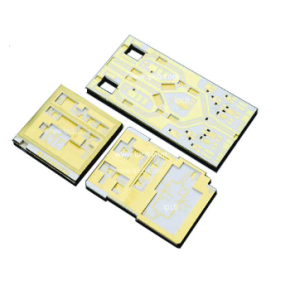Aluminum Nitride PCB is a PCB made of aluminum nitride ceramic material as a substrate on which metal circuits are etched and processed. Aluminum Nitride (Aluminum Nitride, AlN) is a covalently bonded compound with a hexagonal crystal bra-zincite-type structural morphology, which has excellent thermal conductivity, Reliable electrical insulation, low dielectric constant, and dielectric loss, is non-toxic and match the coefficient of thermal expansion of silicon and a series of good characteristics, in the electrical and electronic, aerospace, defense and military. Aluminum nitride has a wide range of applications in power electronics, aerospace, defense and military, automotive and locomotive, communications, and other industrial fields.

Aluminum nitride is the ideal material for a new generation of heat dissipation substrates and electronic device packages, but also can be used in heat exchangers, crucibles, protection tubes, and pouring molds Aluminum nitride can also be used in heat exchangers, crucibles, protection tubes, casting molds, semiconductor electrostatic chucks, piezoelectric ceramics and films, and thermally conductive fillers.
Production process
(1) Preparation of raw materials: Select high-purity silicon powder and other additives required for silicon nitride ceramics as raw materials. Ensure that the raw materials meet the requirements and carry out fine screening and mixing to get a uniform mixture.
(2) molding: the mixed raw materials through the molding process to make the desired shape of the ceramic substrate. Commonly used molding methods include injection molding, pressure block molding extrusion molding, etc.
(3) de-waxing or mold removal: for the use of injection molding of ceramic substrates, the need to carry out de-waxing operations, that is, has been molded in the green body at high temperatures, heating, so that the wax burned out. heating, so that the wax burned out. For other molding methods, mold removal is required to remove the ceramic substrate from the mold.
(4) pre-firing: the molded ceramic substrate into the furnace for pre-firing treatment. The pre-firing process is divided into a heating stage, a holding stage, and a cooling stage The pre-firing process is divided into a heating phase, a holding phase, and a cooling phase. The pre-firing process is designed to remove residual organic matter and perform preliminary sintering to make the substrate denser.
(5) Sintering: The pre-fired ceramic substrate is put into a high-temperature furnace for sintering. Sintering process after a certain heating, holding, and cooling stages, so that the ceramic particles between the fusion of The sintering process goes through certain heating, holding, and cooling stages, so that fusion occurs between ceramic particles and forms a dense structure to improve the mechanical and physical properties of the substrate.
(6) processing and surface treatment: for the completed sintered silicon nitride ceramic substrate, according to the need for further processing, such as cutting, punching, Grinding and polishing, and so on. At the same time, the surface of the substrate can also be special treatment, such as coating metal layer, chemical corrosion laser engraving, etc., to meet the requirements of different applications.
Applications of Aluminum Nitride PCB
(1) Heat dissipation substrates and electronic device packaging
Aluminum nitride ceramics have excellent thermal conductivity, thermal expansion coefficient close to silicon, high mechanical strength, chemical stability, and environmental protection, and are non-toxic, is considered to be a new generation of thermal substrates and electronic device packaging. Aluminum nitride ceramic has excellent thermal conductivity, coefficient of thermal expansion close to silicon, high mechanical strength, good chemical stability environmental protection, and non-toxicity, it is considered as the ideal material for the new generation of heat dissipation substrate and electronic device encapsulation. material, but also an ideal material for large-scale integrated circuit substrates, which is also the main use of AlN ceramics.
(2) Heat exchanger parts
Aluminum nitride ceramics with high thermal conductivity, low coefficient of thermal expansion, excellent thermal conductivity, and thermal shock resistance, can be used as an ideal heat-resistant punch and heat exchange material. For example, aluminum nitride ceramics can be used as heat exchanger materials for marine gas turbines and heat-resistant parts for internal combustion engines. Due to the excellent thermal conductivity of aluminum nitride material Due to the excellent thermal conductivity of aluminum nitride materials, the heat transfer capacity of heat exchangers is effectively improved.
(3) Functional Materials
As one of the third-generation semiconductor materials, aluminum nitride has excellent properties such as wide bandgap, high thermal conductivity, high resistivity, good UV transmittance, and high breakdown field. strength and other excellent properties. Therefore, aluminum nitride can be used to manufacture high-frequency, high-power devices that can be used at high temperatures or under certain radiation scenarios, such as High-power electronic devices, and high-density solid-state memory.
AlN has a forbidden bandwidth of 6.2 eV, strong polarization, and has applications in the fields of mechanics, microelectronics, optics, surface acoustic wave (SAW) devices, high-frequency broadband communications, and so on. band communication and other fields have applications, such as aluminum nitride piezoelectric ceramics and films. In addition, high-purity AlN ceramics are transparent and have excellent optical In addition, high-purity AlN ceramics are transparent, with excellent optical properties, combined with their electrical properties, and can be produced by infrared deflectors, sensors, and other functional devices.
Contact OPCBA.COM to inquire about Aluminum Nitride PCB.

分享到: